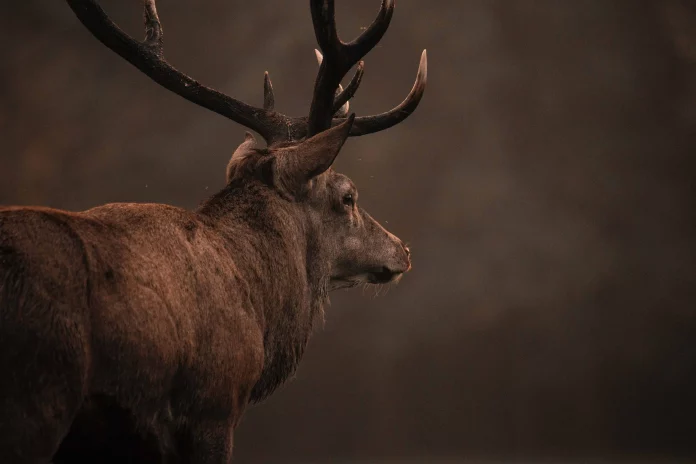There are five species of deer in Sri Lanka, four of which are in the Cervidae family and one of which is in the Tragulidae family. Among the four Cervidea species, it is unclear whether the Hog Deer is native or introduced. They are only found in the southwest’s coastal swamplands. Males in the deer family who use the harem system grow massive antlers. The antlers of older individuals have more tines (branches). Seasonally, these grow and shed. Females judge male fitness based on the size of their antlers. These antlers are mostly used in male-male combat. Because they are a heavy load to bear, males shed them after the breeding season is over.
Most deer species have alpha males who rule a harem of females. In this way, single male monopolists have access to all females. Males deploy considerable strength to protect their harems from other males. Spotted deer and sambar live in such a harem system, but Indian muntjac or barking deer usually live alone or in pairs.
two types of mouse deer are presently recognized in Sri Lanka. They are white spotted mouse deer and yellow striped mouse deer. They speculate that the mouse deer in the highland may be another new and different species. The species in India was previously considered to be the same species as the one in Sri Lanka but is now regarded as a distinct species.
The mouse deer in the family Tragulidae is considered to be an ancient group going back to the Miocene epoch. and also they are thought to be a sister group of the Ruminantia. Mouse deer are not true tree climbers but they are able to clamber up trees that are at a slant and covered in creepers. They do so to escape from terrestrial predators such as dogs. these species are not very vocal but will give a bark-like call when an alarm
Common Types and Features of Deer in Sri Lanka
Spotted deer
The Spotted deer is the most common in Sri Lanka seen by visitors to Sri Lanka’s national parks. Poaching has effectively confined them to protected areas. These innocents are frequently found with Hanuman langurs, and they appear to have a symbiotic relationship. They most likely aid each other in increased vigilance, and they may benefit from the foliage broken by the langurs in terms of foraging.
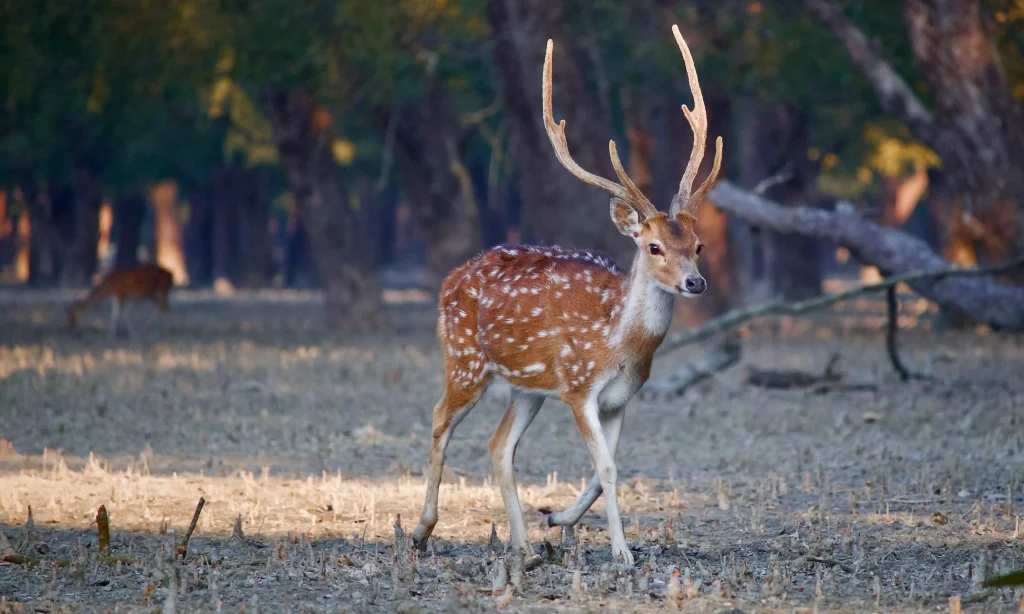
Habitat
Spotted deer can be seen in herds near shelters shaded by trees during the day. Abundant in lowland scrubland associated with the dry zone. Sri Lankan axis deer are mainly active in the early morning and late evening, but they are commonly observed at any time under shady trees near waterholes. Usually, live in groups of 10 to 60 animals, and herds can include up to 100 animals
Distribution
Spotted deer are common in lowland dry forests, savannahs, and scrublands. Rarely seen in dry mountainous areas.
Historically, there is evidence that deer lived in Sri Lanka. Among them, it is said that when Mihidu Maharahat came to Sri Lanka, King Dewanam Piyatissa who was king at that time, met Mihidu Maharahat while hunting Spotted deer.
However, At that time there were very large numbers of Spotted deer living in the entire dry zone, but nowadays that number has decreased considerably.
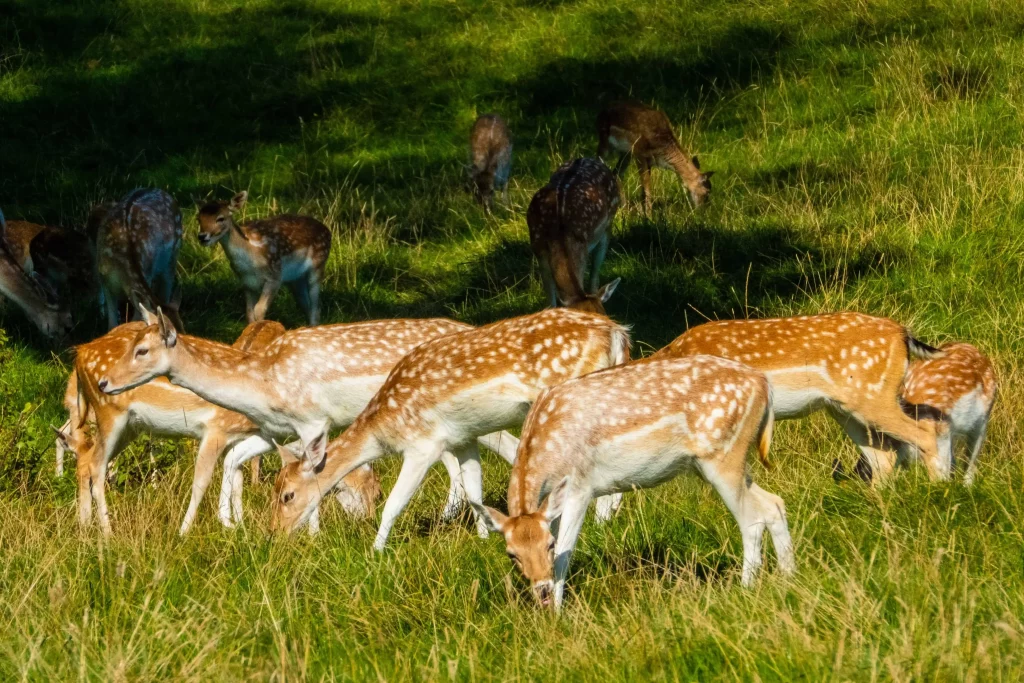
Today thousands of Spotted deer are found in protected areas of the dry zone, with small herds living outside protected forest areas. Large herds are found in protected areas.
A large population of Spotted deer can be seen in the streets of Trincomalee. Especially since they hang out near Fort Frederick. Hindus believe that they have been living in this area since the arrival of King Ravana. so their lives are not disturbed by the people and even the townspeople protect them.
Behavior/ Social Organization
A dominant male leads a herd of females and facilitates female mating. However, mixed herds are also common. Only male deer have antlers.
Diet
Spotted deer are herbivores. They feed primarily on grass but also eat fallen fruit and leaves. It also has close associations with langur, peacock, wild buffalo, and sambar deer and also shares food.
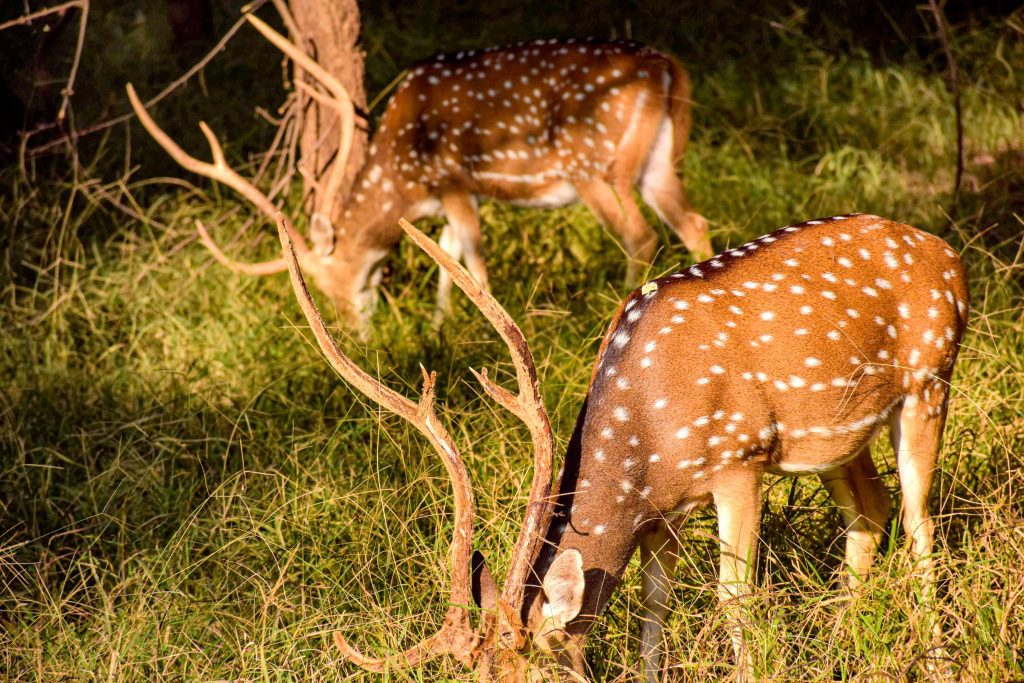
Reproduction and Lifespan
Spotted deer breeding occurs year-round, and males produce sperm year-round. But testosterone levels drop during their antler development. Females have regular menstrual cycles, each lasting three weeks. Females can become pregnant again two weeks after giving birth.
The newborn is kept hidden by the mother for a week after birth, which is a shorter period than most other deer. If the fawn dies, the mother may become pregnant again during that year. Deer mothers can be pregnant twice a year. Babies continue to grow up to seven or eight years.
The average lifespan is around 22 years. However, the longevity in the wild is only five to ten years.
Physical Features
Deer males’ height at the shoulder is 90-100 cm, and females 65-75 cm. The head-to-body length is about 1.7 meters. A mature deer can weigh up to 98-110 kg.
Males are larger than females and only males have antlers.
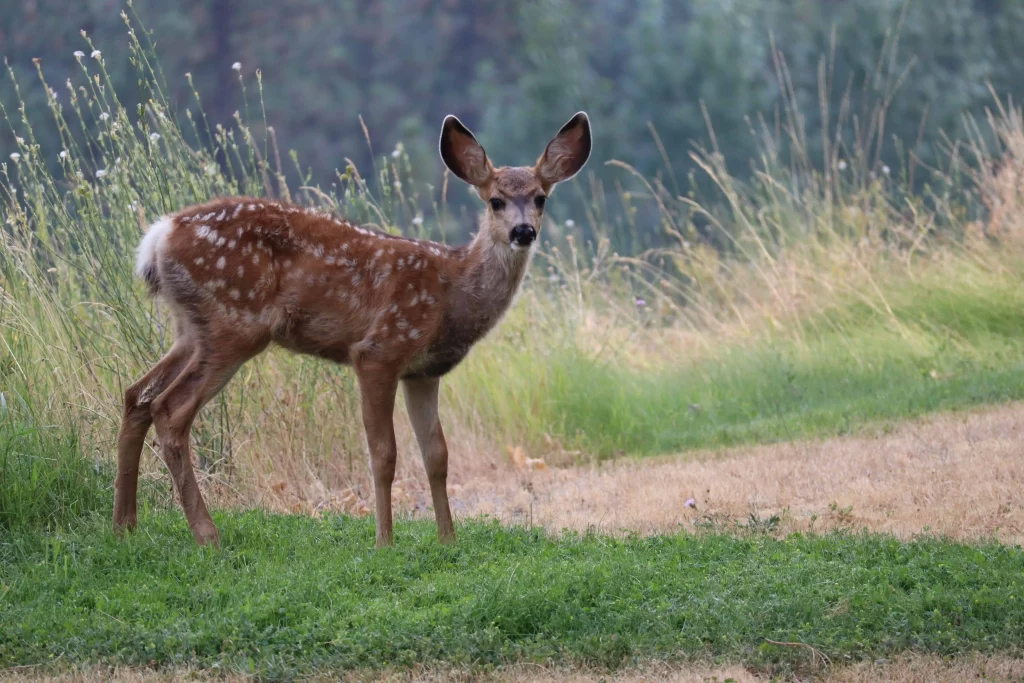
Treates & conservation
The biggest threats that nature has created for them are leopards, bears, and crocodiles in the forests of Sri Lanka. And hunting people for meat is also a threat to their lives.
Where to see
In dry zone forests and national parks. The best places are Yala, Udawalawa, and Wilpattuwa National Parks
Sambar Deer
The Sambar deer in Sri Lanka is the largest member of the deer family found in this island country and lives in the dry zone and humid forest, savanna, and grassland habitats. They can run very fast and jump over obstacles better than other deer due to having long necks and strong legs. Their bodies are yellowish brown to a dark chocolate color. Sri Lankan sambar deer also have antlers but only for males.
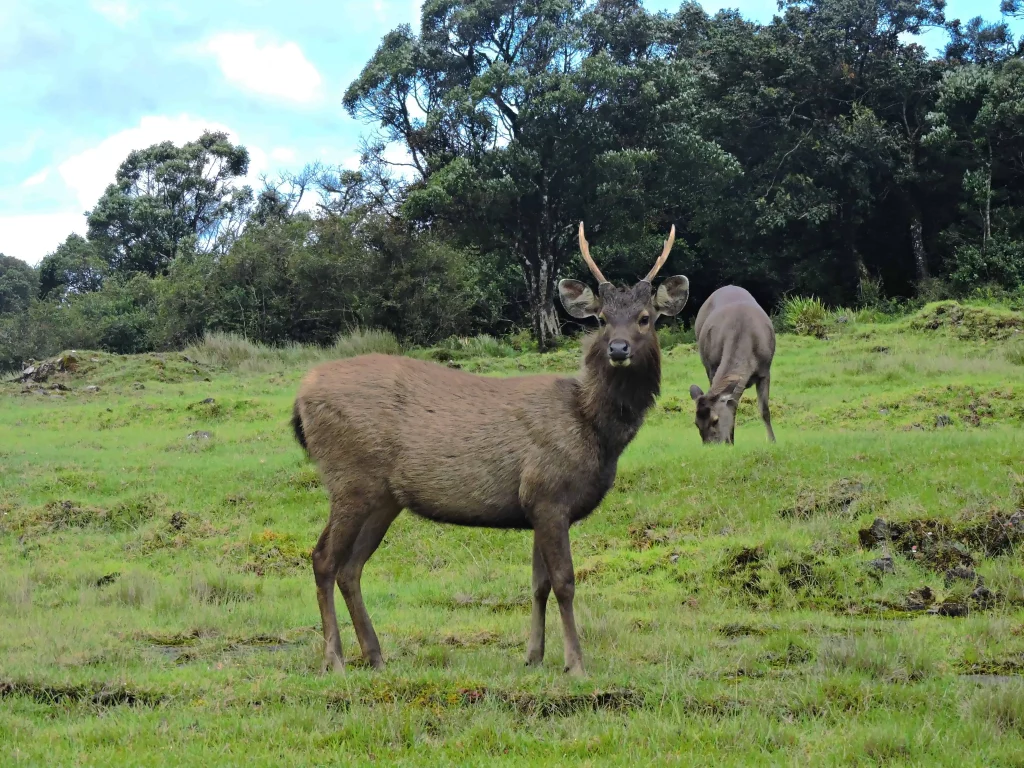
Habitat
Being more active in the evening and at night, it is common for Sambar deer to take a nap in the shade during the afternoon. Their males often live alone and females live in herds. One of the specialties that they have inherited is the ability to swim very well.
Distribution
Sambar Deer prefers to live in areas with dense cover of deciduous shrubs and grasses. Ecosystems with these characteristics have been created mainly in the Horton plains and also the nearby water sources in the dry zone forests of Sri Lanka, so Sambars can also be seen in association with them.
Behavior/ Social Organization
Sambar deer is nocturnal or crepuscular. Males live alone most of the year, while females usually live in small herds of 16 individuals. But in some cases, the normal herd consists of only three or four animals. They usually consist of an older female, her most recent young, and sometimes an immature female. This is an unusual pattern for deer in Sri Lanka that normally live in large groups. Like most deer, the sambar is usually silent but may howl or make short, high-pitched sounds when agitated.
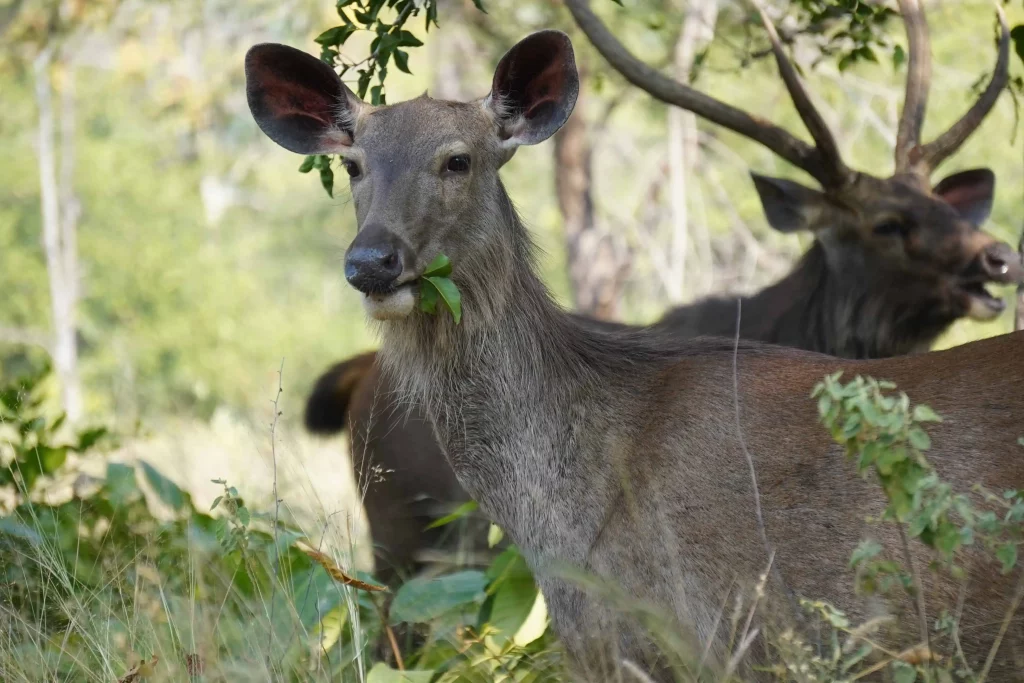
Diet
The sambar’s food comprises berries, bark, grasses, fruits, herbs, buds, and leaves. They spend the majority of their day near the forest’s edge, browsing various plants and trees. Their sophisticated multi-chamber stomach aids in the extraction of nutrients from the difficult meals they consume.
Reproduction and Lifespan
Sambar deer have a polygynous mating system, which means that a single male will mate with as many females as possible. The male will beat the ground to produce a bare area of soil and then wallow in the mud after establishing a territory. This will allow him to appear larger and darker than he is. To attract mates, he will shower his body with pee and rub it against tree trunks. The antlers are very important during the breeding season. Males will lock their antlers, sometimes standing on their hind legs, to drive their opponents away. Typically, the stronger man will win the contest, while the weaker male will disengage without major injury.
Sambars can reproduce all year, however, the months of September through January appear to be the most prevalent for reproduction. The rut is an annual ritual of intricate mating behaviors and physiological changes.
After an eight to nine-month gestation period, the female gives birth to only one fawn at a time; twins are only produced in rare situations. Fawns, who are born with solid brown fur colors and the ability to walk, are anticipated to follow their mother immediately after they emerge from the womb. She is completely responsible for the fawn’s care; the father has no say in its development.
After several months, the fawn is weaned from the mother’s milk and will continue to follow the mother and take solid food. It could take a year or two to gain independence and sexual maturity. The sambar has a lifespan of about 26 years in captivity. However, because of predators and disease, its wild lifespan is only about 15 to 20 years on average.
Physical Features
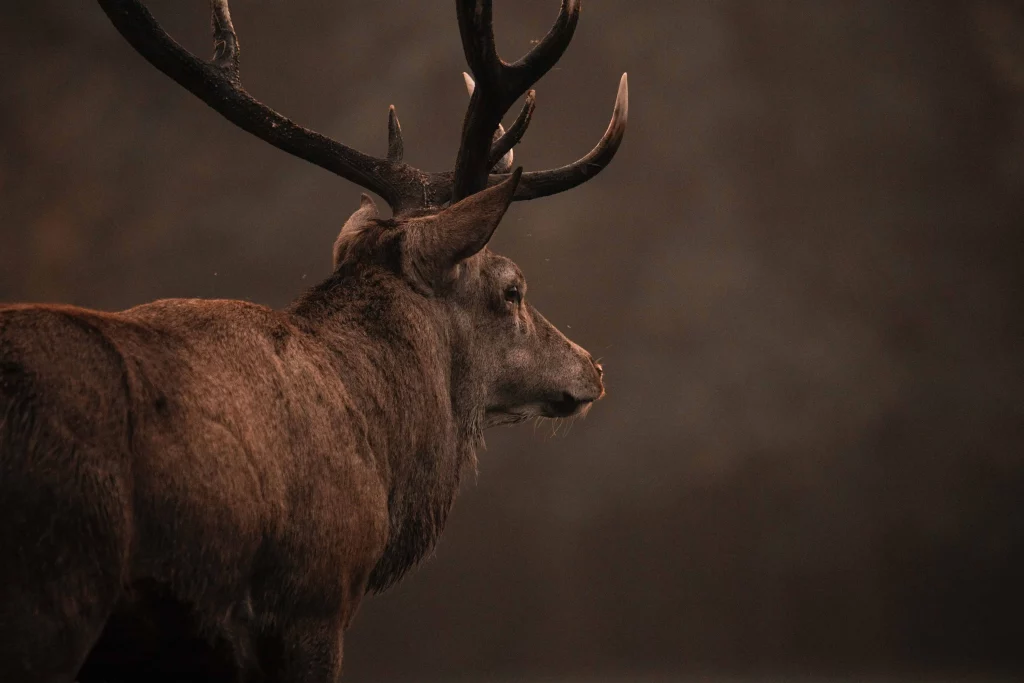
The average height of the Sambar reaches 102 to 160 cm at the shoulder and the average weight is 100 to 350 kg. Head-to-body length ranges from 1.62 to 2.7 meters.
Treated & Conservation
Leopards pose the biggest threat to the Sambar in the wild. When they turn around, they are hunted by Crocodiles when they go to drink water. Apart from this natural threat to Sambar deer, the biggest threat is from humans. Hunting for meat is prominent.
Where to see
Horton Plains National Park is the best place to see Sambar deer in Sri Lanka. Here one can see the highest Sambar deer population living in huge herds and singly. In some cases, they can be seen hanging around tourist spots and spending time lazily.
Apart from this, they can also be seen in parks like Yala and Udawalawa in the dry zone
Barking Deer – Ceylon Spotted Muntjac
Barking deer, also known as Indian Muntjac, is a unique species of deer that is native to India and Southeast Asia and belongs to the family Cervidae. Despite their common name, barking deer do not bark but they produce a distinct dog-like sound when alarmed, hence the name. Barking deer are small in size.
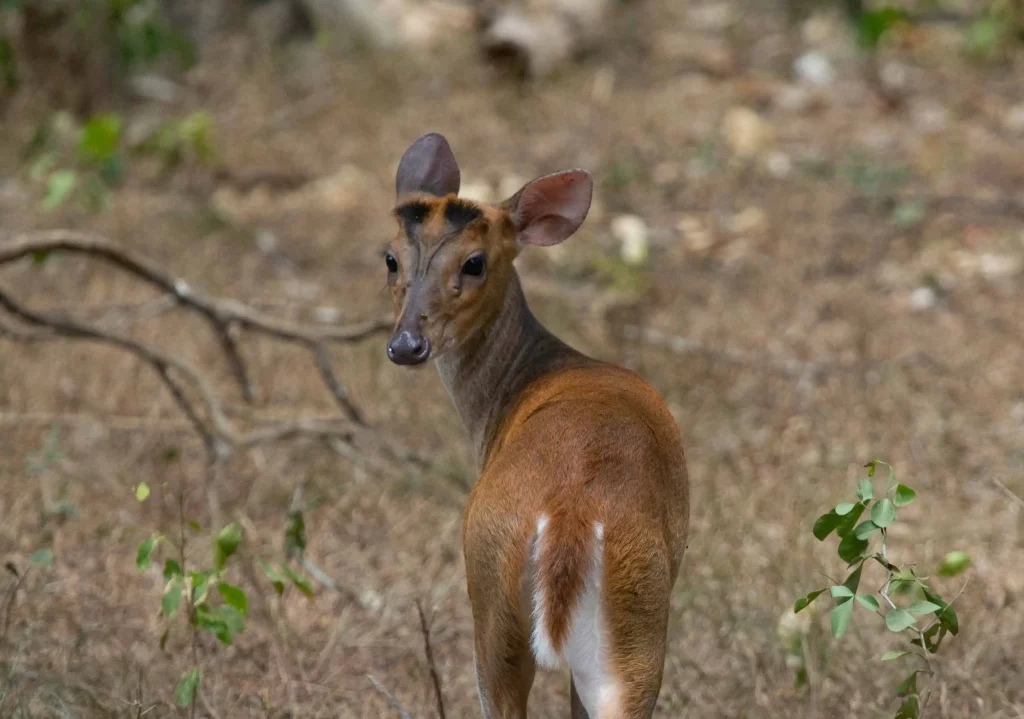
Habitat
The Sri Lankan barking deer inhabits tropical and subtropical deciduous forests, grasslands, savannas, and scrub forests, as well as high elevations on slopes.
They never go far from water. Furthermore, males often have their own territory, which may overlap with the territories of a few females.
Distribution
The Barking deer can be found across Sri Lanka, from the plains to the highlands, but at higher elevations it is rare. They can be found in a wide range of forest types, including rainforests, dry woods, and montane forests. They can also be found in human-inhabited places such as tea estates, household gardens, and suburban neighborhoods.
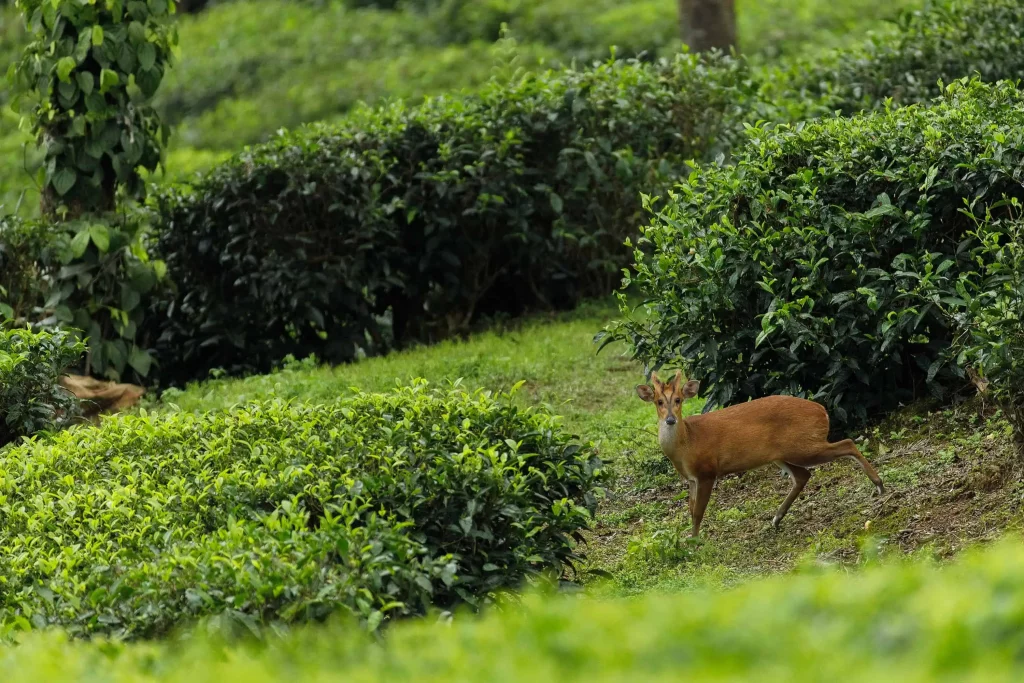
Behavior
The adult Barking Deer is a solitary species that lives in its territory with no other males. Males are frequently spotted battling over territory.
They fight with their small antlers and an even more lethal weapon, their canine fangs. If a male is unable to defend his territory, he will most likely fall victim to a leopard or other predator.
During mating season, territorial lines are momentarily ignored, and males roam in pursuit of females.
These deer are very alert creatures. When in a stressful situation or if it senses a predator, the Indian Munjac will start making a barking sound. Barking is used as a mechanism used only in alarming situations to realize that Munjac has been detected by predators and moved away or revealed itself.
Diet
Barking deer are considered omnivores. They are browsers and grazers, eating grasses, ivy, prickly shrubs, low-growing leaves, bark, twigs, herbs, fruit, sprouts, seeds, tender shoots, bird eggs, and small warm-blooded creatures. Indian muntjacs are usually found foraging near the forest’s edge or in abandoned clearings. Muntjacs are always found in huge tea estates where they feed mostly on tea seeds. Their huge canine teeth aid in eating food.
Reproduction and Lifespan
Barking Deer are polygamous creatures. Females reach sexual maturity between the ages of one and two. These females are polyestrous, with cycles spanning 14 to 21 days and estrus lasting two days. The gestation period is six to seven months, and they typically bear one baby at a time, though twins are occasionally produced.
Several variables, including habitat quality, predation, disease, and human activity, can affect the lifespan of the Ceylon Spotted Muntjac. Males may have shorter lifespans than females due to breeding and territorial fights.
However, the Barking deer lifespan is unknown exactly, but it is thought to be between 10-15 years.
Physical features
The Indian muntjac, especially those found in cooler climates, has a short but highly velvety, thick, and dense coat. The coat’s color varies from dark brown to yellowish and grayish brown depending on the season. The Indian muntjac’s coat is golden tan on the dorsal side and white on the ventral side, with dark brown to reddish brown limbs and a dark brown face.
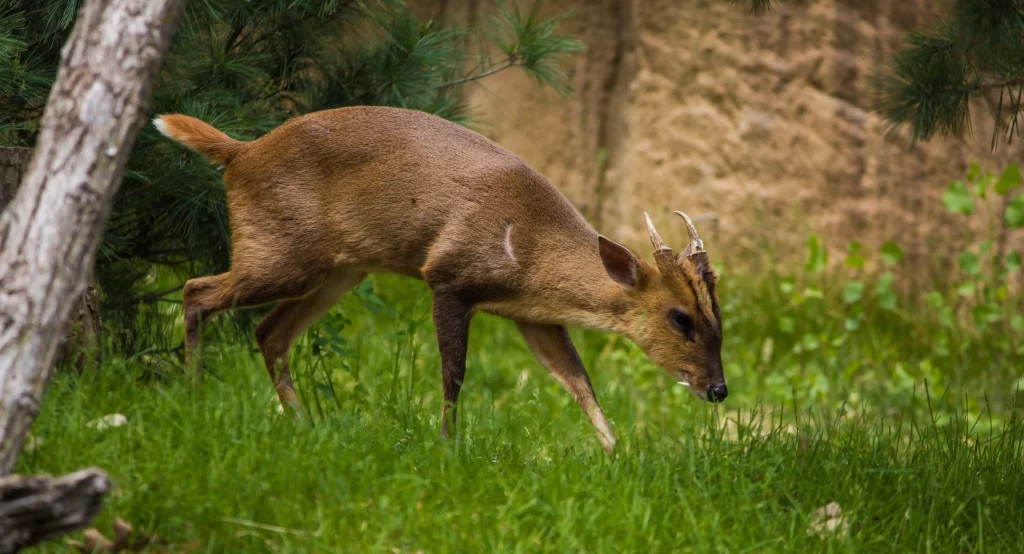
The ears, on the other hand, have very little hair that barely covers them. Male muntjacs have antlers that are only approximately 1-2 inches long. Males also have somewhat lengthened upper canines that are roughly an inch long and curve slightly outward from the lips, allowing them to inflict considerable injury on other animals or other members of the population while exhibiting aggression.
Males are often larger than females. Muntjacs have a body length of 35-53 inches and a height of 15-26 inches and a weight is about 16-34 kg
Treat and Conservation
Indian muntjac deer are killed for their flesh and skin. They are frequently persecuted on the outskirts of agricultural areas since they are considered a pest due to crop damage and tree bark tearing.
Where to see
The best place to see Indian muntjac is Wilpaththuwa National Park
Hog Deer
Among the six members of the deer family in Sri Lanka, the hog deer is not much talked about, but the epidemic member in Sri Lanka. Hog deer are spread only in a very limited area, some call this species an animal species that was introduced to Sri Lanka for hunting purposes during the colonial period.
However, the Hog deer is facing a threat of extinction and has been named as a species facing the threat of extinction according to the 2007 IUCN red lists.
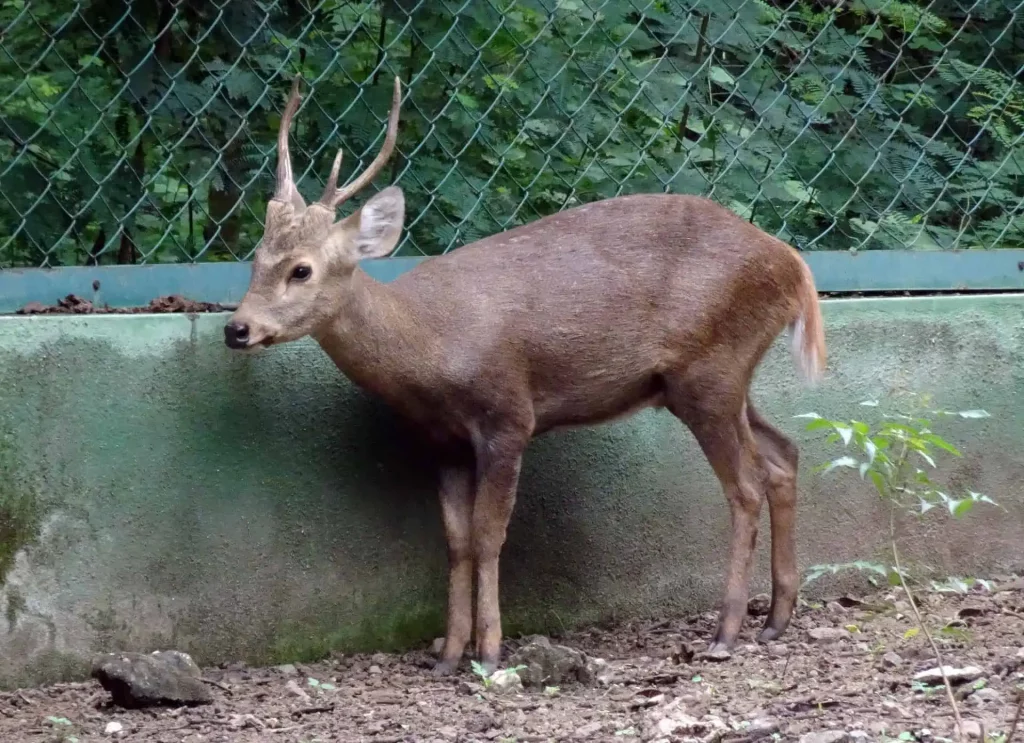
Habitat
Hog deer are solitary animals. However, they can also be seen in small herds in open areas where food is abundant. They are most active in the morning and evening and are rarely seen during the day. In heavily hunted areas and rural areas, hog deer have become nocturnal. They mostly live in the same area and rarely migrate.
It is their usual practice for members of a group to flee in different directions as soon as they feel threatened. They hide in dense vegetation until the danger is over
Distribution
These animals, which have a very limited distribution in the country, can be found in the Kalutara and Galle districts of the wet zone and in several places in the middle of the country as well as in the low-lying areas around the coastal region. They also live in small numbers in Matugama, Bulathsinghala, Ambalangoda, Gonapinwala, Atkandura, Karandeniya, Thelwatta, Batapola, Uragasmanhandiya, and Madu river islands.
Swamps, mangrove forests, cinnamon plantations, and mangroves are their habitats, but the population of these animals is rapidly decreasing due to the clearing of suitable habitats in the areas where these animals are reported.
Behavior/ Social Organization
Their males show somewhat aggressive traits and contribute to courtship and reproduction with a single female. They do not create harems like other deer species. Hog deer do not have a hoarse voice like most other deer species.
Diet
Hog deer are herbivores. The diet of this animal usually consists of grasses and it likes to eat Paddy leaves, cinnamon leaves, and leaves of vegetable crops. Due to this, Hog deer is popular among farmers as an animal that damages crops.
Reproduction and Lifespan
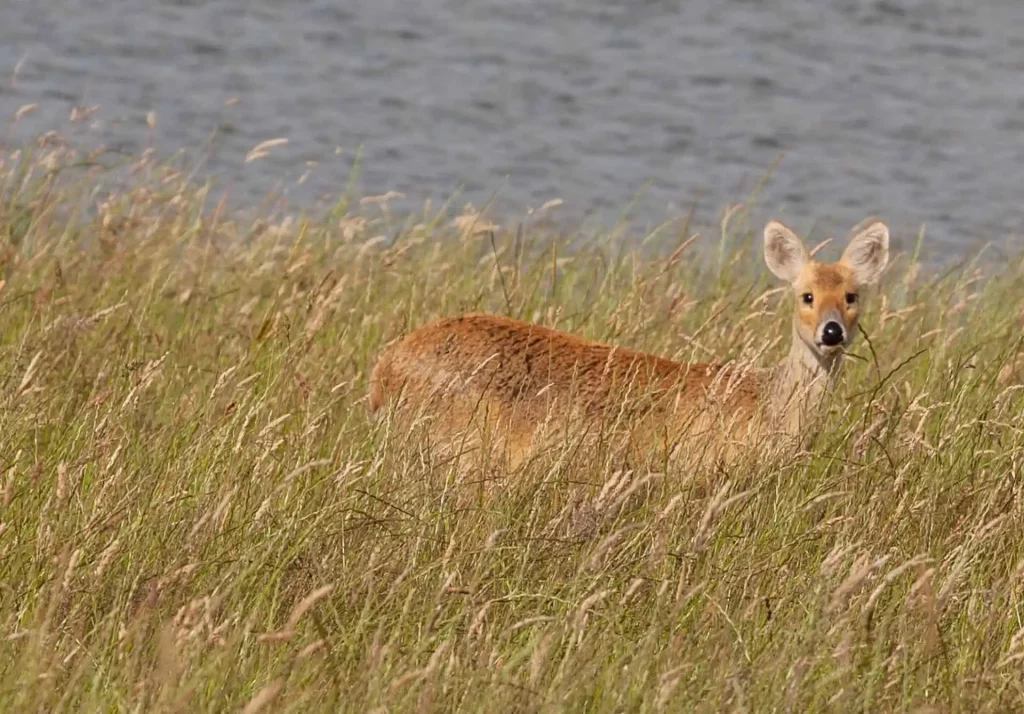
Hog deer have a polygamous mating system. However, some males of this species exhibit monogamous behavior, which means they are mating with only one female and guarding only one. Populations in the natural range breeding season are August-October. During this period, males engage in intense competition to win a female and aggressively defend their mating rights.
Females give birth to a single litter in May-July, after 8 months of pregnancy. Deer are usually born in isolated dense grassy areas because they are protected from predators in that area. During the first few days of calf life, the mother feeds the cub and shelters the child, and lives on its own hide in the bush. During this time she occasionally visits the fawn to nurse the baby. The calf is weaned at 6 months and reaches puberty at 8-12 months of age.
Physical features
Considering the physical characteristics of Hog deer, their height is about 70 cm at the shoulder and they weigh approximately 50 kg.
Their females are very small, about 61 cm in height and about 30 kg in weight. The species itself is claimed to have a long body and relatively short legs. The ears are rounded, and adult animals have a lighter color on the face and neck. The coat is fairly thick and usually a uniform dark brown. The underside of the tail is white, which they use as a unique warning system, and in case of danger, they will bring out the white hairs.
Trats and Concervation
Leopards and crocodiles are the main threats they encounter in the wild. But in some cases, they can also be seen preying on Pythons. Humans have also become a big threat to their lives. It is because they are hunted for meat. And due to the damage caused by them to the farmlands, the life of this species has also been threatened due to the laying of power lines
However, According to the Wildlife and Flora Protection Ordinance, the Hog deer is a protected animal. It is a punishable offense to injure, kill, capture, or possess a dead or captured animal or part of an animal (including meat) or sell meat, or possess skins or horns of these animals.
White-spotted mouse deer
White-spotted mouse deer can be called the cutest and most innocent animal among the wild mammals in Sri Lanka. The looks a bit like a deer calf and is the smallest member of the deer family.
However, they do not belong to the Cervidae family, to which Sri Lankan deer belong but belong to the Trangulidae family. Even though their name is called mouse deer, they have nothing to do with rats.
Habitat
White-spotted mouse deer live in deep moist forests. However, habitat loss due to deforestation has forced them to adapt to inhabit more open environments such as secondary forests and urban areas and are more active at night and spend the day hiding in the bushes to avoid predators.
Distribution
Sri Lankan white-spotted mouse deer is found in forested and densely vegetated areas throughout the island, including protected areas such as national parks and reserves.
The distribution of white-spotted deer in Sri Lanka is primarily restricted to the wet zone of Sri Lanka, which is the southwestern part of the island that receives the highest rainfall. Within this region, it is found in a variety of habitats including rainforest, lowland, and montane forests, and scrub.
Behavior/ Social Organization
The White-spotted mouse deer is an innocent and shy creature that is rarely seen by humans. When scared, it is customary to run away quickly and hide in the surrounding bushes. They are not usually fast runners, so zigzags run methodically. This makes it challenging to capture. Loud noises and sudden movements startle them. Also, they are very shy and usually run away even if they see a large animal. However, if you are patient and quiet, you may be lucky enough to see them up close.
Diet
The mouse-deer’s food is primarily composed of fruits, but when the fruit is rare, it will also consume plants, insects, snails, and small animals. They can take nutrients from plants that other animals cannot digest. They are solitary creatures in general, although they will congregate during mating season or when there is a bountiful food source.
Reproduction and Lifespan
It is difficult to study White-spotted mouse deer because they are secretive and elusive species. We do know that they reproduce all year, with peak breeding seasons happening during the wet months. Female mouse deer typically have a single calf, though twins have been observed. The gestation phase lasts about six months. Mothers will care for their children till they reach the age of three to four months.
As you may know, mouse deer are small animals, and their young are much smaller. As a result, large predators frequently hunt them. To protect their young, mouse-deer moms frequently carry them in their mouths. Even with this protection, many young mouse-deer do not survive to be adults. This is because they are so little and vulnerable that they are frequently killed before they can mature. Some make it to adulthood despite the difficulties that young experience. These adults can then produce children, completing the life cycle and increasing their population numbers.
The usual lifespan is roughly ten years, although the species only lives for about six years in captivity.
Physical Features
White-spotted mouse deer is the world’s smallest hoofed mammal. The Sri Lanka species weigh between 0.7 and 8.0 kg, with an average length of 45 cm and an average height of about 30 cm.
Treat and Conservation
Because of their small size and fearful disposition, mouse deer make easy prey for predators like tigers, leopards, snakes, and birds of prey. Wild cats are some of the mouse deer’s most prevalent predators. These predators frequently pursue and ambush their prey, making it difficult to flee. Humans, in addition to natural predators, provide a hazard. Two of the most serious risks to this species are hunting and habitat loss. Hunters may target the mouse deer for its meat, which is considered a delicacy in some cultures.
Conclusion
In the heart of Sri Lanka’s picturesque landscapes, deer roam freely, adding a touch of magic to this island paradise. From the iconic Axis deer to the elusive Sambar deer, each species tells a unique story of survival and adaptation. While they face challenges, dedicated conservation efforts give hope for a brighter future. As we continue to explore and cherish the biodiversity of this stunning island, let’s also work together to protect the enchanting deer that make Sri Lanka their home.
Frequently Asked Questions
- What is the best time of year to observe deer in Sri Lanka?
The dry season (from May to September) is generally the best time to observe deer as they congregate around water sources, making them more visible.
- Can I see deer in Sri Lankan national parks?
Yes, many national parks in Sri Lanka, such as Yala and Wilpattu, offer excellent opportunities to spot deer in their natural habitat.
- What kind of deer are in Sri Lanka?
Sri Lanka is home to several deer species, including the Axis deer (Spotted deer), Sambar deer, and Hog deer.
- Does Sri Lanka have deer?
Yes, Sri Lanka does have a diverse population of deer species.
- What is the smallest deer in Sri Lanka?
The smallest deer in Sri Lanka is the Hog deer (Axis porcinus).
- What is the meaning of sambar deer in sinhala?
In Sinhala, Sambar deer is called “Hinawalaniya,” which is a term commonly used to refer to this species.

